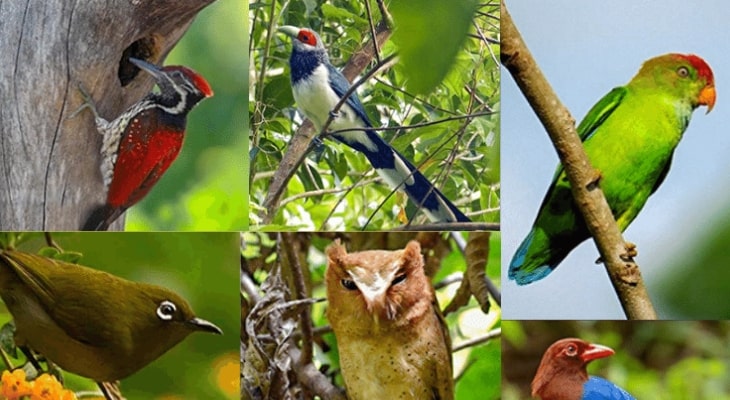
This tiny beautiful island is home to 34 Endemic birds of Sri Lanka. There are an array of birds species that have been observed on the island of Sri Lanka is 4,92, of which 219 breeders reside in the country, and most are within the zone of wet. The months between November and April are believed the most appropriate months to observe the vast majority of these species that are endemic to the island.
Sri Lanka is one of the world’s Top Endemic Bird Regions, according to BirdLife International. The Kithulgala along with Sinharaja forest in the lowland are among the most suitable locations to see the vast proportion that these birds. Horton Plains National Park in the hills is the most suitable spot to view the endemics that live their life in the mountains.
The variety in species native to Sri Lanka has fluctuated over the years. The reason for this is to in large part to the phenomenon of “close taxonomic revisions”. The species that are endemic varied from a minimum of just 20 species to a maximum of 47. Since 1977, the total was around 21.
The number increased to 23 after the introduction of two species in the year. Many authorities have accepted the figure from 1990 and drawn more attention to the number of species native to Sri Lanka.
in 1994, Wijesinghe published the list of birds found in Sri Lanka which considered the inclusion of three species. However, the decision was not well-received because the reasoning was not in accordance in line with strict taxonomic guidelines.
Later publications on the birds’ life of Sri Lanka and the South Asia region was not listed the three species endangered species. However, some Sri Lankans considered the three species suggested in 1994 by Wijesinghe to be acceptable.
It is possibly due to an exaggerated interest in the rising amount of birds that are endemic to create a more complete ornithological view and to increase the demand for bird watching. In 2001 Warakagoda along with Rasmussen identified a brand new bird species called the Serendib Scops-owl Otus Thilo Hofmann.
Since 1868, when the Sri Lanka whistling-thrush (Myophonus blighi) was initially identified, it has been one of the earliest species discovered in Sri Lanka. There are some ideas for changes to the taxonomic status at the species level as well as the status of endemics within Sri Lanka. In common names, the prefix “country “Sri Lanka” is commonly used for indigenous species.
However, some are still concerning the use of “Ceylon” when referring to common names for species. This suggests that it is an expression of the change of Sri Lanka, the formal English name for Sri Lanka from Ceylon to Sri Lanka.
List of Endemic Birds in Sri Lanka
01. Sri Lanka spurfowl (Galloperdix bicalcarata)
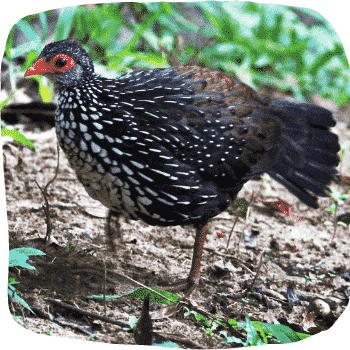
The Sri Lanka spurfowl is best known as Hanban Kukula (හබන් කුකුලා). The bird can be found in the dense rainforests in Sri Lanka. It is included in the pheasant family, and it is very secretive that can not find easily. If someone is willing to see this fantastic bird Sinharaja and Kithulgala is the best site to visit. The Sri Lanka spurfowl makes nests on the ground, and it lays 2-5 eggs in a scrape. Both male and female birds have wings and tails with brown upperparts. Their multiple metatarsal spurs are the best reason for their specific name.
02. Sri Lanka junglefowl (Gallus lafayettii )
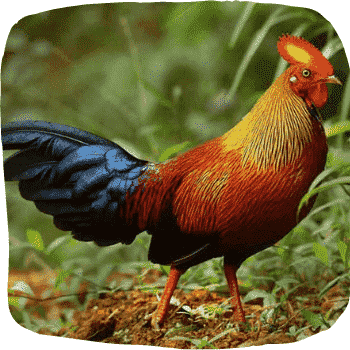
It has the distinction of being the national bird of Sri Lanka. The Sri Lankan junglefowl, like other junglefowl, is sexually dimorphic. The male is substantially more significant than the female, with more vibrant plumage and wattle and comb that are greatly exaggerated. In the genus Gallus, there are four species of birds. It can be found in woods and scrub habitats and has been seen in places like Kitulgala, Yala, and Sinharaja. In a nest, females lay 2-4 eggs. They spend most of their time scratching various seeds, fallen fruit, and insects on the ground to eat.
03. Sri Lanka wood pigeon (Columba torringtoniae)
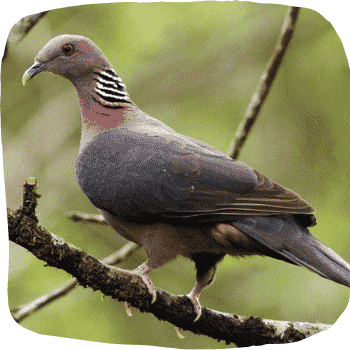
Sri Lanka wood pigeon is an indigenous resident breeding bird found only in Sri Lanka’s mountains. This species lay 01 white egg in their stick nest in a tree in moist evergreen woodlands in the central highlands. Vegetables make up the majority of its diet. During the breeding season, it makes an owl-like hooting sound. The Sri Lankan wood pigeon has a length of 36 cm. The head and underparts are lilac, while the upperparts and tail are dark greys, becoming paler on the belly. This pigeon can be found in abundance in the Horton Plains National Park’s forests.
04. Sri Lanka green pigeon (Treron pompadora)
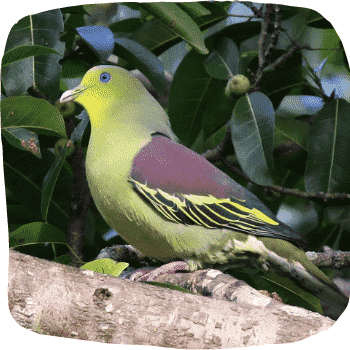
Green pigeon of medium size with yellow face and yellowish line on the wing. The male has a maroon back, while the female has a greenback. Green pigeons in Sri Lanka are mainly seen singly or in small groups.
Its flight is quick and direct, with regular beats and the occasional sharp flick of the wings that pigeons are known for. It loves to feed on the fruits and seeds of many different plants. It lays two tiny white eggs in a stick nest on a tree.
05. Sri Lanka hanging parrot (Loriculus beryllinus)
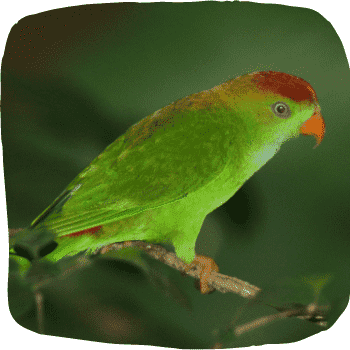
Sri Lanka hanging parrot is a small, mostly green, with a short tail, measuring just 13 cm in length. The rump and crown of the adult are crimson. The nape and back of the neck are tinted oranges. Pale blue across the chin and throat. The irises are white, and the beak is red.
Outside of the breeding season, they usually travel alone or in small groups. It builds its nest in tree holes and lays 2–3 eggs. It migrates in small groups, owing to the scarcity of the fruit, seeds, buds, and blooms that make up its food.
06. Layard’s parakeet (Psittacula calthrapae)
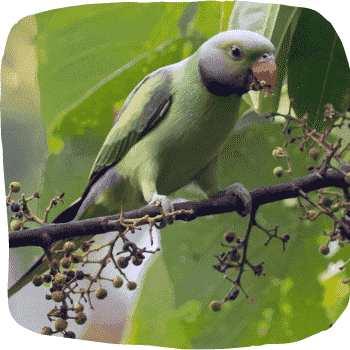
Small groups of people live in the Wet Zone’s upper levels of humid forest and drier, forested areas outside of it, in both the lowlands and hills. It’s quite frequent in this area. It migrates in small groups, owing to the scarcity of the fruit, seeds, buds, and blooms that make up its food.
The Layard’s parakeet is a green parrot with a tail reaching 13 cm in length. It builds its nest in big tree holes and lays 3–4 white eggs. A green-collar separates the adult’s bluish-grey head and back.
07. Red-Faced Malkoha (Phaenicophaeus pyrrhocephalus)
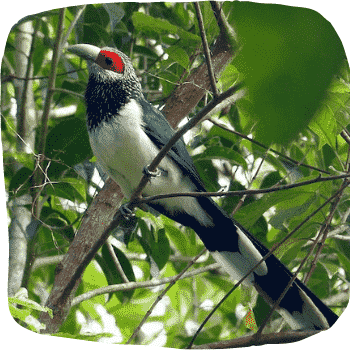
Malkoha of moist lowland and mid-hill forest with a large, beautiful malkoha. Bright red face, yellowish bill, white belly, and long, white-tipped tail distinguish this species. It eats insects and tiny vertebrates and can be found in the deep canopy of tall trees. Usually seen in pairs and frequently encountered in mixed flocks led by Orange-billed Babblers. Despite its dazzling look, it might be difficult to spot. Usually silent, but occasionally emits a gentle clucking sound and a static-like call. It loves to build its nest in a tree and lays 2-3 eggs on average.
08. Green-billed Coucal (Centropus chlororhynchos)
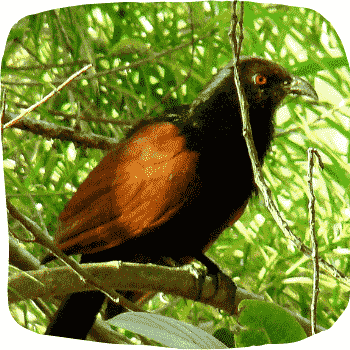
Lowland and mid-hill woodland in medium-sized coucal. At 43 cm, it is a medium to large bird. It has a purple-black head and body, maroon above and black below wings, and a dark green long tail. The bill is a unique bright green colour. The sexes are very similar. The lesser coucal is smaller and less contrasted than the more common greater coucal. Because of the dense terrain in which it lives and its retiring character, this species is difficult to notice despite its size and distinctive call. Although snails are delicious, it eats various insects, caterpillars, and tiny vertebrates.
09. Sri Lanka Serendib scops-owl (Otus thilohoffmanni)
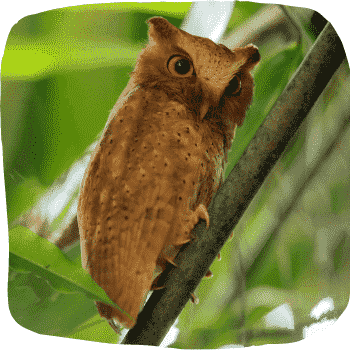
Common species are found in extensive wetland rainforests in the lowland wetlands of Sri Lanka. The Serendib Scops Owl’s breeding biology is poorly understood. It probably builds its nest in tree cavities created by woodpeckers or barbets. This species has a tiny population that is rapidly diminishing due to habitat degradation. It is exclusively nocturnal, like most owls, and hunts insects (such as beetles and moths) close to the ground. Their origins are unknown at this time. According to research, this owl is free from competition from other nocturnal birds. The size is about 17cm.
10. Sri Lanka chestnut-backed owlet (Glaucidium castanotum)
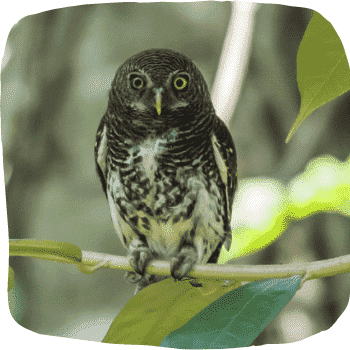
This owl is quite attractive. The Chestnut-backed Owlet is one of Sri Lanka’s indigenous birds that are rarely seen. It prefers dense, low- to mid-country wet-zone woods with a canopy that is mostly made up of the upper story. It’s mostly confined to a few undisturbed woodland sections and has been observed at elevations of up to 2,000 meters. Early in the spring, the breeding season begins. In bare tree hollows, eggs are laid. The eggs are a bright white colour. As the call develops, the syllables get slightly slower. They are both crepuscular and nocturnal hunters who prey primarily on insects.
11. Sri Lanka grey hornbill (Ocyceros gingalensis)
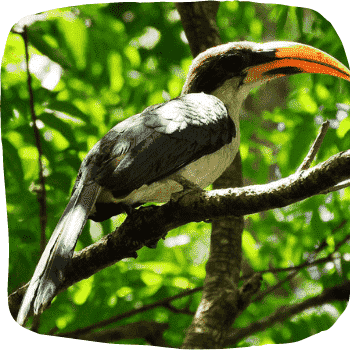
The female bird lays up to four white eggs in a tree hole that is sealed off with dirt, droppings, and fruit pulp during incubation.
There is only one tiny opening, barely large enough for the male to feed the mother and chicks. It usually eats figs, but it also occasionally eats small rodents, reptiles, and insects.
12. Crimson-backed flameback (Chrysocolaptes)
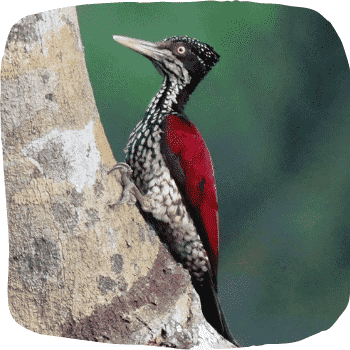
33cm in the largest extravagant size of this bird. The male is red, and the sexes are nearly identical except for the female’s white and black markings. The female’s earlobes are darker, and her tail is darker than the male’s (the male’s earlobes are crossed by white angular, dark bars). The bird can be found in various locations with dense forest cover. Visit the mansions and gardens if you’re near the forest. This couple is inextricably linked. From October to March is the breeding season. The nest builds in a hole in the tree. A total of 1–3 white eggs are deposited.
13. Red-backed flameback (Dinopium psarodes)
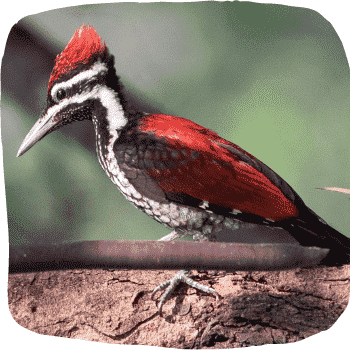
The red-backed flameback is endemic to Sri Lanka and is found across the country, not only in the north. It measures length about 28 cm and is predominantly dark crimson with black back margins up to the wings. A red crown is present. Subtropical or tropical dry woods, subtropical or tropical wetland forests, and subtropical or tropical mangrove forests, as well as man-made areas such as backyards, are its natural habitats. Ants are its primary food source. Eat alone, in pairs, or with your family. Puppies are born twice a year on average. At a time, two or three eggs are laid.
14. Yellow-fronted Barbet (Psilopogon flavifrons)
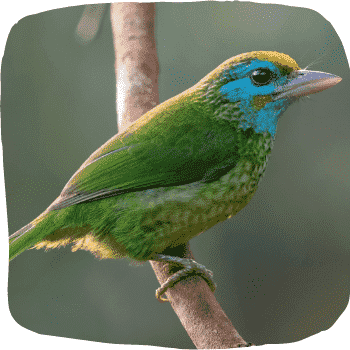
The yellow-fronted barbet (Psilopogon flavifrons) is an Asian barbet found in subtropical and tropical moist forests, marshes, plantations, and rural gardens up to an altitude of 2,000 meters in Sri Lanka (6,600 ft). Its plumage is green, with a golden crown and blue patches beneath the eyes, on the throat, and the chin. It measures 21–22 cm (8.3–8.7 in) in length and weighs 57–60 g (2.0–2.1 oz) in weight. It eats berries, fruits, and insects on occasion. It lays 2-3 eggs on its nest in a tree hole.
15. Crimson-fronted barbet (Psilopogon rubricapillus )
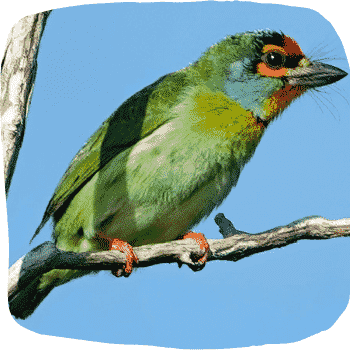
Psilopogon rubricapillus is a species of dark red front barbet known as (ySka fldÜfgdarejd) in Sri Lanka. It’s an indigenous species that only live in tropical lowland damp woods. A short-necked bird with a huge head and a short tail. The beaks are dark, thick, and short. The parents create holes in trees with their small, harsh beaks for their nests. They lay 2-4 white-coloured eggs at a time, and both parents take turns incubating the eggs. Both parents alternate incubating eggs and caring for their children. Fruits, insects are eaten by the bird. Barbets in Sri Lanka breed in the first half of the year.
16. Crimson-fronted barbet (Psilopogon rubricapillus )
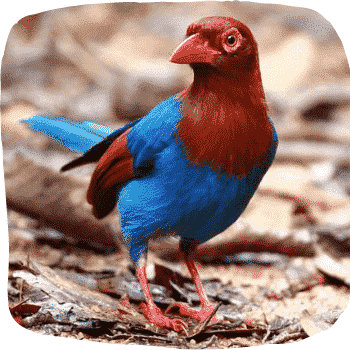
This bird is known as (leysfn, a,d) in the Sinhala Language. At 42–47 cm, Sri Lanka Blue Magpie is similar in size to the European Magpie. The adults have a long white-tipped tail and chestnut head and wings. The bill and legs are also crimson. It eats small frogs, lizards, insects, and although it will also consume fruit. The cup-shaped stick nest is usually found in trees or shrubs, and 3–5 eggs are frequently placed. The white eggs have brown spots all over them. Only the female incubates the eggs built by both sexes and fed by both.
17. Black-capped bulbul (Pycnonotus tricolor)
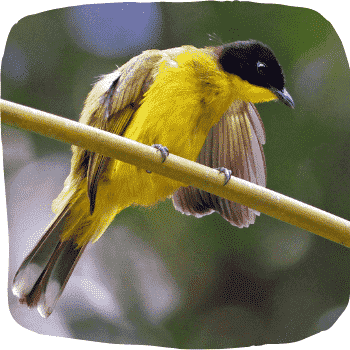
In the Sinhala language of Sri Lanka, this bird is known as (හිස කලු කොන්ඩයා). The black-capped bulbul has a yellow neck and brownish eyes and is nearly crestless. It’s yellowish-green on top and yellow on the bottom. This is woodland and dense scrub bird. It builds its nest under a shrub, and a typical clutch consists of two to four eggs. The black-capped bulbul eats fruit and insects. Forests, wooded regions, and gardens are all good places to look for it. It’s common to see them in pairs. From March to September, breeding records are kept.
18. Sri Lanka yellow-eared bulbul (Pycnonotus penicillatus Blyth)
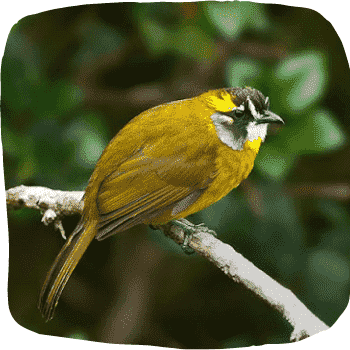
The yellow-eared bulbul has a long tail and measures around 20 cm (7.9 in) in length. The upper parts are olive, while the underparts are yellowish. There are golden ear tufts and a yellow patch below the eye, while the crown of the head is grey. There is a white tuft in front of the eye, and the throat is similarly white. The plumage of both sexes is identical, but juvenile birds are duller than adults. The flight is bouncy and resembles that of a woodpecker. Yellow-eared bulbuls lay two eggs in a typical clutch and build their nest in a shrub. Fruit and insects are their main sources of nutrition.
19. Sri Lanka drongo (Dicrurus lophorinus)
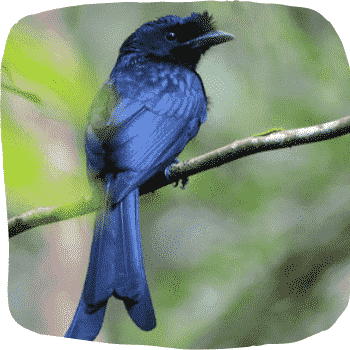
The Sri Lanka drongo (Dicrurus lophorinus), sometimes known as the Ceylon crested drongo, belongs to the Dicruridae family of birds. Metallic blue or greenish-blue gloss, black feathers, arches, helmet-like logo, deep forktail, red eyes, and homosexuality characterize them. It is a woodland bird, like other drongos, that can only be found on the boundaries of forests, plantations, and forested gardens. It feeds on insects from open perches, as do other drongos. It’s a fantastic imitation of other birds’ calls, yet it always sounds metallic.
20. Sri Lanka bush-warbler (Elaphrornis palliseri)
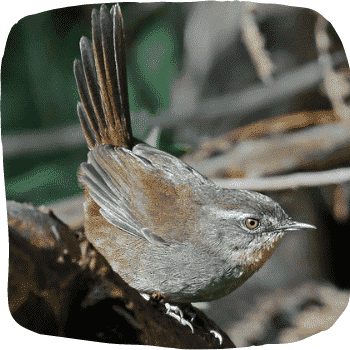
The Sri Lanka bush warbler is a bird that prefers deep forest vegetation and is frequently seen near water. Two eggs are placed in the nest, which is erected in a shrub. At 14 cm, this warbler is a medium-sized bird. The adult is characterized by a primary brown back, pale grey underparts, a broad tail, and short wings. The throat is orange-tinged and has a faint supercilium. The sexes are identical with most warblers, but young birds lack throat coloration. The loud song, which has an explosive queet, is often the only way to recognize males.
21. Sri Lanka brown-capped babbler (Babbler Pellorneum fuscocapillus)
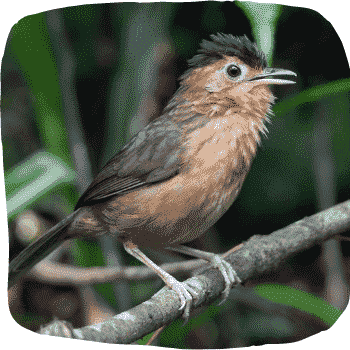
The Sri Lanka brown-capped babbler is best known as Dubaru Demalichcha (¥nqre fou,sÉpd). It frequently hunts in pairs in the undergrowth, rustling among dry, dead leaves or low canopy for insects, worms, and other small animals. When foraging for food, this bird has an unusual habit of walking as well as hopping — it is only Sri Lankan Babbler that walks. The nest appears to be an untidy dome of dead leaves and other debris on the outside, yet it is clean on the inside. The normal clutch consists of 2 pale eggs with dark blotches. In the early spring, their breeding season begins.
22. Sri Lanka scimitar-babbler (Pomatorhinus melanurus)
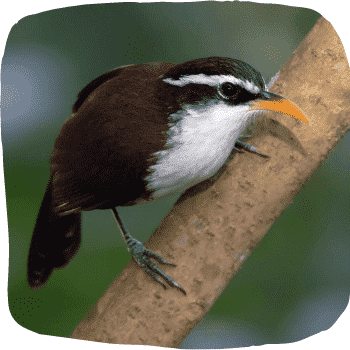
The long sickle-shaped yellow beak of the Sri Lanka scimitar-babbler, the habit of feeding by examining the trunks of trees, and the very distinctive cry make it easy to identify the birds. Males and females have similar appearances and are around 22 cm long. Except in the northern peninsular, the bird can be found in all relevant humid tall forest sections on the island. Its current range is mainly constrained to this preferred environment. They are reported to breed during the months of December and February. A total of 3-5 white eggs are deposited.
23. Sri Lanka orange-billed babbler (Argya rufescens)
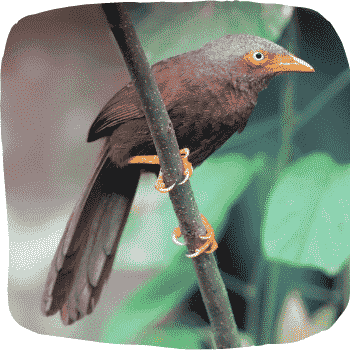
It’s a 25-centimetre reddish-brown feathered animal that’s only found in Sri Lanka. The main species of mixed feeding flocks in wet zone woods such as Sinharaja Forest Reserve and Makandawa Forest Reserve in Kitulgala is the Sri Lanka Orange-billed Babbler. This bird may be found primarily in the low country wet zone and hill zone woods. These birds are mainly restricted to pristine woodland sections in the Wet Zone. August and September months are ideal for breeding. Nest – constructed of twigs, open and shallow. 2-3 clutches. The eggs are a gleaming greenish-blue colour.
24. Sri Lanka ashy-headed laughingthrush (Argya cinereifrons )
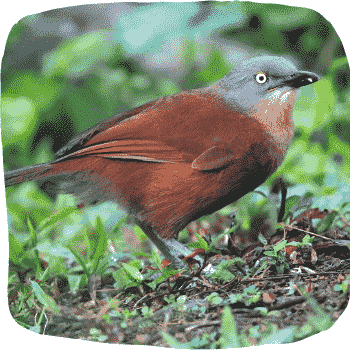
The ashy-headed laughingthrush is a lanky bird with a long floppy tail that is 23 centimetres (9 in) in length. Ashy-headed laughingthrushes, like other babbler species, can be seen in flocks of up to a dozen birds and in the mixed feeding flocks that are common in tropical Asian jungles. They consume insects primarily, but also jungle berries. It hides its nest under a bush, surrounded by dense vegetation. A typical clutch consists of three or four eggs. It has a grey head with a white throat and is rufous-brown above and deep buff below.
25. Sri Lanka white-eye (Zosterops ceylonensis)
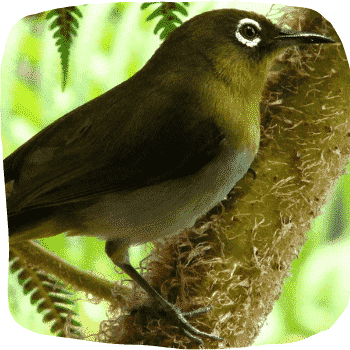
Sri Lanka white-eye (is;eishd) at around 4000 feet. Dark olive green covers the upper body and the sides of the neck. The blade is pale green, with a black crown and forehead. The back is green, and the wings and tail are brown. It is social, creating big flocks that only split off when the breeding season approaches. It nests in a tree and lays three unspotted pale blue eggs. Though mostly insectivorous, Sri Lankan white-eye also consumes nectar and other fruits.
26. Sri Lanka myna (Acridotheres tristis)
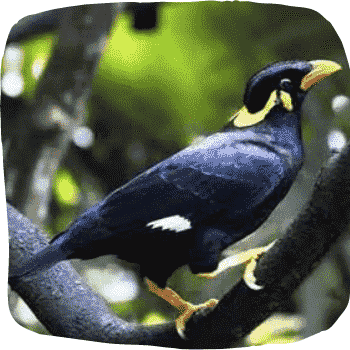
Sri Lanka’s Myna The green-glossed black plumage of these 25-29 cm long birds is purple-tinged on the head and neck. The powerful legs have a bright yellow colour, and the neck has golden wattles. The Southern Hill Myna, which is also found in Sri Lankan woodlands, is distinguished by its wattles’ shape and position and its stouter orange-red bill. This is the only Mynah without wattles (skin folds on the sides of the face). Males and females have similar appearances, although juveniles have duller bills. The Sri Lanka Myna, like most starlings, is omnivorous, consuming fruit, nectar, and insects.
27. Sri Lanka white-faced starling (Sturnornis albofrontatus)
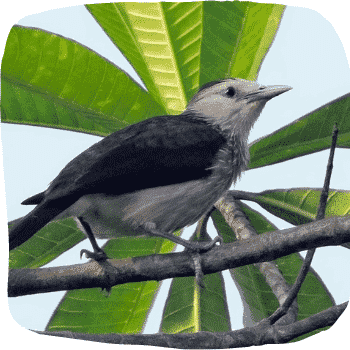
White-faced Male starlings grow to be about 21.6 cm long, while females are somewhat smaller. The iris of young people is brown with a slight white ring around it. Starlings are strictly arboreal creatures who rarely venture to the ground. Fruits and insects are their favourite foods, as they sneak up on them along with trees. Nothing was known about this bird’s breeding and nesting behaviours until recently. White-faced starlings have a small altitudinal range, ranging from 300 meters to 1,200 meters above sea level. The eggs are pale blue and 25 × 20 mm in size. So yet, just two eggs have been found in a nest.
28. Sri Lanka whistling-thrush (Myophonus blighi)
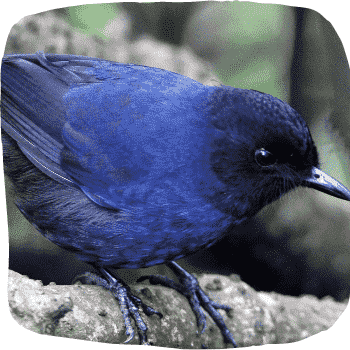
Sri Lanka whistling-thrush Males are dark blue with darker heads and backs than females. The shoulders, supercilia, and forehead have bright blue spots. The female has a vivid blue shoulder patch like the male but is brown above and chestnut below. It can be found in Sri Lanka’s highlands, in the impenetrable jungle or other dense woodlands near water. It is omnivorous, consuming insects, frogs, earthworms, and berries, among other things. It builds a clean cup-shaped nest in a shrub or on a ledge near water to lay 1/2 eggs. Although multiple birds may be loosely linked in suitable habitat, it does not form flocks.
29. Sri Lanka spot-winged thrush (Geokichla spiloptera)
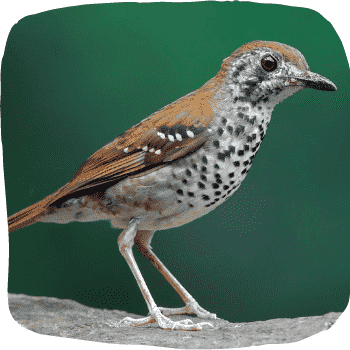
In Sri Lanka, Sri Lanka spot-winged thrush is an endemic resident breeder. Spot-winged thrushes are omnivores who prefer insects to fruit. They get their food from the ground. Two dark bars run over the pale face. Light brown above with a double-wing bar of white dots, adults of this medium-sized thrush measure 21-27 cm (8.3 to 10.6 inches) in total length and weigh 70 g. The vegetation-lined loose cup nests are set in a tree fork. There are 2-3 buff or bluish-green eggs deposited. Every year, this species produces two broods.
30. Sri Lanka scaly thrush (Zoothera imbricata)
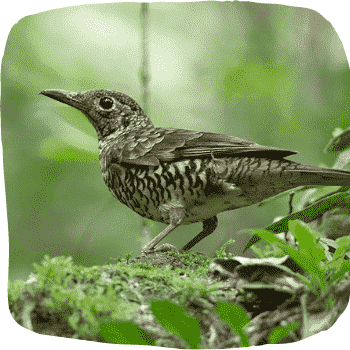
The Sri Lanka thrush, also known as Lanka scaly thrush, belongs to the Turdidae family of thrushes. This bird is a non-migratory resident breeder found in the island of Sri Lanka’s southwestern rainforests. The olive-brown upper parts contrast with the rufous buff underparts of this rare forest-loving ground thrush. The scaly texture on the body and a larger and longer bill with a chunky appearance makes it easier to identify. Lower slopes and higher elevations are the only places where they can be found. The majority of its time is spent on the ground, flipping over dead leaves searching for an insect meal.
31. Sri Lanka dull-blue flycatcher ( Eumyias sordidus )
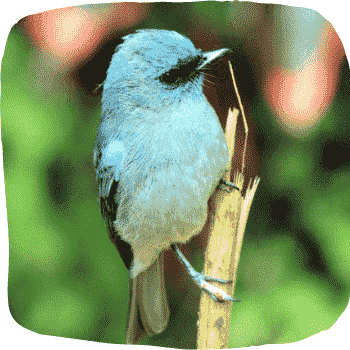
This species has a length of 15 cm. It has a loud, melodic song and is shaped like a spotted flycatcher. Adults have an ashy blue coloration and a pale belly. Between the broad black bill and the eye, there is a black patch that is bordered with brighter blue above and below. Females are slightly duller than men, although both sexes are similar. This species is an indigenous resident breeder in the central Sri Lankan hills. In the deciduous alpine woodland, the dull-blue flycatcher breeds. Two or three brown-spotted pink eggs are deposited in a typical clutch.
32. Sri Lanka white-throated flowerpecker (Dicaeum vincent)
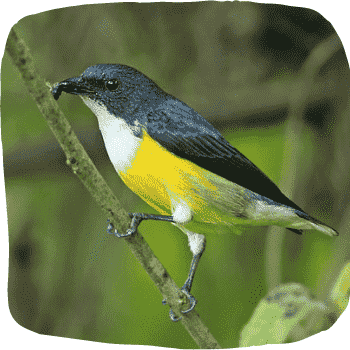
A little passerine bird, the White-throated Flowerpecker (Dicaeum vincens), is a white-throated flowerpecker. It has a 10 cm long short, thick petal, a short tail, a short curved bill, and a tubular tongue. It lives alone, in pairs or small family groups, and is difficult to locate because it prefers the woods or the neighbouring mountains. A fabricated tree is frequently used to construct the nest. It’s a hanging pocket on a plant with an entry at the top that feels down, somewhat below the support branch. The two eggs are dark white with purple-red irregularities. They’re around 16 mm by 12 mm in size.
33. Sri Lanka woodshrike (Tephrodornis affinis)
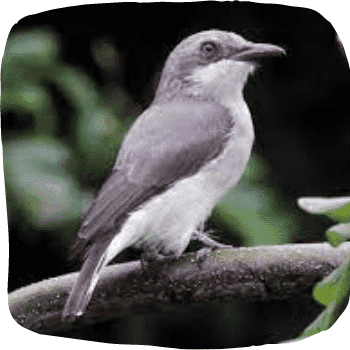
A small grey songbird with a heavy bill, dark mask, and white eyebrows, the Sri Lanka wood shrike is a small grey songbird with a strong bill, dark mask, and white eyebrows. The underside is a light shade of white. In Sri Lanka’s dry zone, lowland and lowland forest areas are mostly inhabited. Typically, vegetation species are found in pairs or small groups. They can be distinguished from a large (but larger) giant woodpecker by their pale eyebrows and plain underparts. The song is a sequence of resonances, “wee-wee-wee” The number of notes in the series and their delivery speed varies.
34. Sri Lanka Swallow (Cecropis hyperythra)
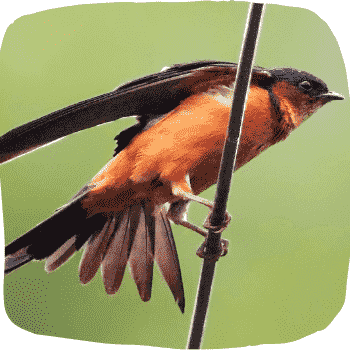
The Sri Lanka swallow is a huge swallow with a deeply forked tail, and its deep rufous underside and navy blue rump with no marks is a distinct trait of this species. It may be distinguished from the red-rumped swallow by its rufous underbelly. It’s a passerine, which means it has three forward-pointing toes and one backwards-pointing toe, allowing it to perch. It can be found in both the lowlands and slopes of Sri Lanka, in various open country habitats such as farm fields and moderately forested areas. It lives in pairs or small groups most of the time.
Conclusion : Endemic Birds of Sri Lanka
Whether it’s a resident bird or a migrant bird Sri Lanka is Birds Paradise because it is famous for its natural beauty. So: The birds of Sri Lanka make this beauty even more. According to much research, there are many endemic Birds of Sri Lanka. So from this article, you can go through a pleasant journey to the Endemic Birds of Sri Lanka. Enjoy it!
Image source ebirds







